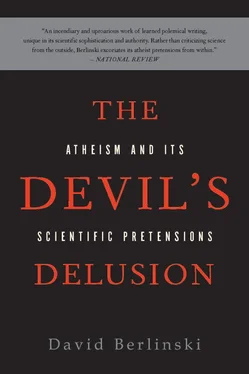If this is one question, it leads at once to another. The laws of nature are what they are. They are fundamental. But why are they true? Why do material objects attract one another throughout the universe with a kind of brute and aching inevitability? Why is space-and-time curved by the presence of matter? Why is the electron charged?
Why? Yes, why ?
An appeal to still further physical laws is, of course, ruled out on the grounds that the fundamental laws of nature are fundamental. An appeal to logic is unavailing. The laws of nature do not seem to be logical truths. The laws of nature must be intrinsically rich enough to specify the panorama of the universe, and the universe is anything but simple. As Newton remarks, “Blind metaphysical necessity, which is certainly the same always and everywhere, could produce no variety of things.”
If the laws of nature are neither necessary nor simple, why, then, are they true?
Questions about the parameters and laws of physics form a single insistent question in thought: Why are things as they are when what they are seems anything but arbitrary?
One answer is obvious. It is the one that theologians have always offered: The universe looks like a put-up job because it is a put-up job. That this answer is obvious is no reason to think it false. Nonetheless, the answer that common sense might suggest is deficient in one respect: It is emotionally unacceptable because a universe that looks like a put-up job puts off a great many physicists.
They have thus made every effort to find an alternative. Did you imagine that science was a disinterested pursuit of the truth?
Well, you were wrong.
APOTHEOSIS IN THE STANDARD MODEL
At the beginning of the 1960s, physicists understood that there were four forces in play in the material world: the force of gravitation, the electromagnetic force, and the weak and strong nuclear forces. They had in addition come into possession of a remarkably large number of elementary particles, so many that Enrico Fermi complained that had he wished to memorize their names, he would have become a botanist.
Thirteen years later, three of the four forces and virtually all of the elementary particles had been successfully classified, and the forces partially explained because partially unified. This is the triumph of the Standard Model.
It is a model comprising three parts. The first is quantum electrodynamics, which offers a successful quantum theory of the electromagnetic field, one satisfying principles of both quantum mechanics and special relativity. Quantum electrodynamics was completed in the late 1940s by Richard Feynman, Julian Schwinger, and Sin-Itiro Tomonaga; and because it describes electromagnetic phenomena—light, electricity, magnetism—it retains a vivid connection with the world of daily life in which computer chips and electric toasters hum in accordance with its laws. Without it, we would all be lost, or at best, inconvenienced.
The second part of the Standard Model, Steven Weinberg, Sheldon Glashow, and Abdus Salaam created in their electroweak theory. As the name might indicate, their theory unified the weak nuclear force and the electromagnetic force. By showing that, deep down, two forces were really one, Weinberg, Glashow, and Salaam demonstrated that when properly seen, the weak nuclear force and the electromagnetic force were manifestations of some ancient primordial form of unity. In the world as it is, of course, very little of this unity is left. The weak nuclear force and the electromagnetic force are today distinct. To see things as they really are, it is necessary to see things as they really were. The time when things really were unified occurred shortly after the Big Bang. To account for the fact that in the world as it is observed, the weak force and the electromagnetic force are distinct, Weinberg, Glashow, and Salaam appealed to the audacious idea that what physicists could today see of the weak and electromagnetic forces represented nothing more than a form of broken symmetry, as when couples remember how happy they once were amid the shambles of their discontent.
There is finally quantum chromodynamics, which provides a theory of the strong nuclear force. In 1954, C. N. Yang and Robert Mills outlined a daring generalization of quantum electrodynamics. Their paper described a new physical theory. It also predicted the existence of particles that no experiment had revealed and strange new symmetries.
With the proliferation of quarks and their varieties in the 1960s, new particles and symmetries did emerge, and they proved to be precisely those that would allow a Yang-Mills theory to take charge of the strong nuclear force and give it direction and a general shaping-up.
There followed a decisive step, the last. Experiments had indicated that in some bizarre fashion, particles bound by the strong nuclear force behaved in ways quite unlike particles governed by the weak nuclear force—or any other force, for that matter. Their interactions seemed to grow stronger as the distance between them increased, almost as if they were being held together by a rubber band that remained flaccid at short distances and tense at longer distances. Many marriages are like this. In the early 1970s, David Gross, H. David Politzer, and Frank Wilczek discovered in their theory of asymptotic freedom that this was an expected consequence of a Yang-Mills theory of the strong nuclear force.
The Standard Model was complete.
If the Standard Model is a triumph, is not one that is unalloyed. The Standard Model cannot explain the transition from the elementary particles to states of matter in which the elementary particles are bound to one another and so form complex structures. It is in this sense incomplete.
The Standard Model is not only incomplete but arbitrary. Like any physical theory, it contains a good many numerical parameters—at least twenty-one. These designate specific numerical properties of the model. These cannot be derived from the theory. Physicists thus find themselves very much in the position of a master couturier obliged to allow one of his finest creations to appear on the runway with its basting lines and tacking pins still affixed.
Above all, the Standard Model is inadequate because it does not incorporate the force of gravity. General relativity stands apart. The two great theories of the twentieth century have not been reconciled. They invoke different languages, different ideas, and different techniques of calculations. The great technical triumphs that made the Standard Model a success are with respect to general relativity unavailing because ineffective. General relativity and quantum mechanics resemble two aging matadors facing the bull of nature, the both of them retiring flustered after a number of halfhearted veronicas and ineffective passes.
The bull is still there, snorting through velvet nostrils. He does not seem the least bit fatigued.
For the past quarter-century, a very substantial portion of the community of mathematical physicists has been engaged in work on a subject known as string theory. The effort has consumed the best minds of a generation.
Whereupon the inevitable, Wait a minute, strings?
Yes, strings. A string is just what its name suggests. It is a wiggling one-dimensional object, something like a garden hose although somewhat smaller, and extended in length but not width. Strings can be straight, they can be curved, they can join with themselves to form loops, and what is more, since they are strings, they can vibrate under tension.
Читать дальше













